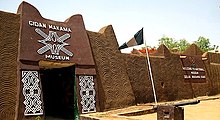
Kano is a city in northern Nigeria and the capital of Kano State. It is the second largest city in Nigeria after Lagos, with over ten million citizens living within 449 km2 (173 sq mi). Located in the Savanna, south of the Sahel, Kano is a major route of the trans-Saharan trade, having been a trade and human settlement for millennia. It is the traditional state of the Dabo dynasty who have ruled as emirs over the city-state since the 19th century. Kano Emirate Council is the current traditional institution inside the city boundaries of Kano, and under the authority of the Government of Kano State.

Sokoto is a major city located in extreme north-western Nigeria, near the confluence of the Sokoto River and the Rima River. As of 2006, it has a population of over 427,760. Sokoto is the modern-day capital of Sokoto State and was previously the capital of the north-western states. Modern Sokoto is known for trading sheepskins, cattle hides, leather crafts, kola nuts and goatskins.

Katsina, likely from "Tamashek" or mazza (men) with "inna" (mother) is a Local Government Area and the capital city of Katsina State, in northern Nigeria. Katsina is located some 260 kilometres (160 mi) east of the city of Sokoto and 135 kilometres (84 mi) northwest of Kano, close to the border with Niger Republic.

Sudano-Sahelian architecture refers to a range of similar indigenous architectural styles common to the African peoples of the Sahel and Sudanian grassland (geographical) regions of West Africa, south of the Sahara, but north of the fertile forest regions of the coast.

Kano State is one of the 36 states of Nigeria, located in the northern region of the country. According to the national census done in 2006, Kano State is the most populous state in Nigeria. The recent official estimates taken in 2016 by the National Bureau of Statistics found that Kano State was still the largest state by population in Nigeria. Created in 1967 out of the former Northern Region, Kano State borders on Katsina State to the northwest for about 210 km, Jigawa State to the northeast for 355 km, Bauchi State to the southeast for 131 km, and Kaduna State to the southwest for 255 km. The state's capital and largest city is the city of Kano, the second most populous city in Nigeria after Lagos. The incumbent governor of the state is Abba Kabir Yusuf. He was sworn in on 29 May 2023.

Ado Bayero CFR, LLD, JP was the Emir of Kano from 1963 to 2014.
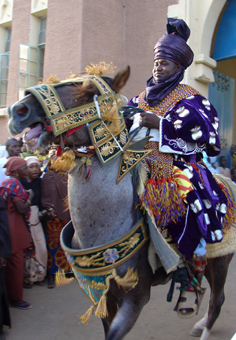
The Durbar festival is an annual cultural, religious and equestrian festival celebrated in several northern cities of Nigeria including Kano, Katsina, Gombe, Akko Emirate, Sokoto, Zazzau, Bauchi, Bida, Lafia and Ilorin. The festival marks the end of Ramadan and also coincides with the Muslim festivities of Eid al-Adha and Eid al-Fitri.
Muhammad dan Yakubu, known as Muhammad Rumfa was the Sultan of Kano from 1463 until 1499. His reign was characterized by wealth and opulence and signaled the rise of the Sultanate's commercial dominance in the region. Under the guidance of famed Berber Scholar, Muhammad Al-Maghili, he was also responsible for much of the Islamization of Kano. In total, the Kano Chronicle attributed twelve innovations to him including; extending the city walls, building a large palace, the Gidan Rumfa, promoting slaves to governmental positions and establishing the Kurmi Market. Rumfa's reforms also proved to be the catalyst that would propel Kano to its political peak, resulting in the first Kanoan Empire under his grandson Muhammad Kisoki.
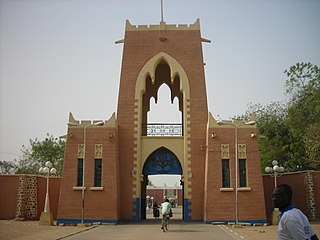
The Gidan Rumfa, sometimes called the Gidan Sarki, is the palace of the Emir of Kano. Located in the city of Kano, Kano State, Nigeria, it was constructed in the late 15th century. Since the reign of Rumfa, it has continuously been the residence of the traditional authority in Kano and was retained by the Fulani jihadists who took over traditional authority in Kano in the early 19th century. It currently has an area of 33 acres (130,000 m2).

The Hausa are a native ethnic group in West Africa. They speak the Hausa language, which is the second most spoken language after Arabic in the Afro-Asiatic language family. The Hausa are a culturally homogeneous people based primarily in the Sahelian and the sparse savanna areas of southern Niger and northern Nigeria respectively, numbering around 86 million people, with significant populations in Benin, Cameroon, Ivory Coast, Chad, Central African Republic, Togo, Ghana, as well as smaller populations in Sudan, Eritrea, Equatorial Guinea, Gabon, Senegal and the Gambia.
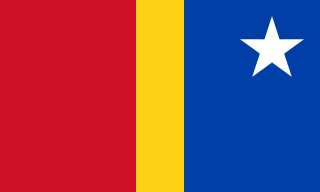
The Kano Emirate was a Muslim state in Northern Nigeria formed in 1805 during the Fulani jihad when the Muslim Hausa-led Sultanate of Kano was deposed and replaced by a new emirate which became a vassal state of the Sokoto Caliphate. During and after the British colonial period, the powers of the emirate were steadily reduced. The emirate is preserved and integrated into modern Nigeria as the Kano Emirate Council.
The following is a timeline of the history of the city of Kano, Nigeria.
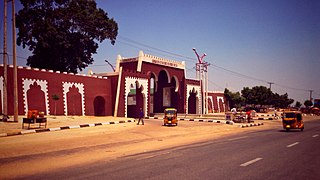
The Ancient Kano City Walls were ancient defensive walls built to protect the inhabitants of the ancient city of Kano. The wall was initially built from 1095 through 1134 and completed in the middle of the 14th century. The Ancient Kano City Walls were described as "the most impressive monument in West Africa".
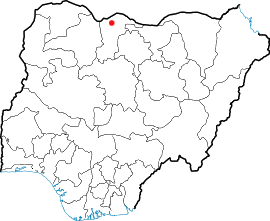
Durbi Takusheyi is a burial site and major archaeological landmark situated about 32 km east of Katsina in northern Nigeria. The burials of the early Katsina rulers span a 200 year period from the 13th / 14th century AD to the 15th / 16th century AD. The recovered sets of artifacts provide material historical clues as to the emergence of Hausa identity and city states. The grave goods comprise a local, indigenous component besides foreign elements which attest to networks that reached far into the Islamic Near East. Katsina represented a focal point for trans-Saharan trade during the late middle ages, a crucial phase in local history during which the Hausa city states emerged.

The Dambazawa are a Fulani clan residing mainly in Kano State, Nigeria. They were among the key promoters, planners and executors of the Fulani Jihad in Kano, which took place between 1804 and 1807 under the leadership of Shehu Usuman dan Fodiyo. The clan was said to be the top financier of the jihad because it was said to be extremely wealthy at the time of the jihad. Other Fulani Clans that participated in the Jihad included: the Jobawa, the Yolawa, the Sullubawa, the Danejawa and others, as well as a contingent of the native Hausa people led by Malam Usuman bahaushe. Together they formed a formidable force and toppled the 158 year Kutumbawa dynasty led by its last ruler Muhammad Alwali dan Yaji dan Dadi bakutumbe who ruled between 1781 and 1806.

Hausa architecture is the architecture of the Hausa people of Northern Nigeria. Hausa architectural forms include mosques, walls, common compounds, and gates. Hausa traditional architecture is an integral part of how Hausa people construct a sense of interrelatedness with their physical environment. The architectural program used in this society is one disciplined by Isalm and results in a highly organized spatial structure which is used to express features of Hausa culture.
Gates of Hausa kingdoms are gates or walls (ganuwa) that formerly enclosed Hausa kingdoms. In ancient times, each kingdom was enclosed with a wall that contained various gates. During battles, the gates were closed as a war strategy. Each gate has a name and a gatekeeper. In the past, especially at night, the gatekeeper was in charge of a single gate at all time. All of the gates are assigned to a single person today.
Baffa Babba Danagundi, popularly known as Baffanyo, a Nigerian politician, former Majority Leader in the Kano State House of Assembly

Babban Gwani, also known as Mallam Mikhaila, was an influential 19th-century Hausa architect and builder who flourished during the reign of the 61st ruler of Zazzau, Nigeria, Abd al-Karim ɗan Abbas. He was the Sarkin Maigini of his time, appointed by Shehu Usman dan Fodio. This position was passed down to his direct male descendants.
